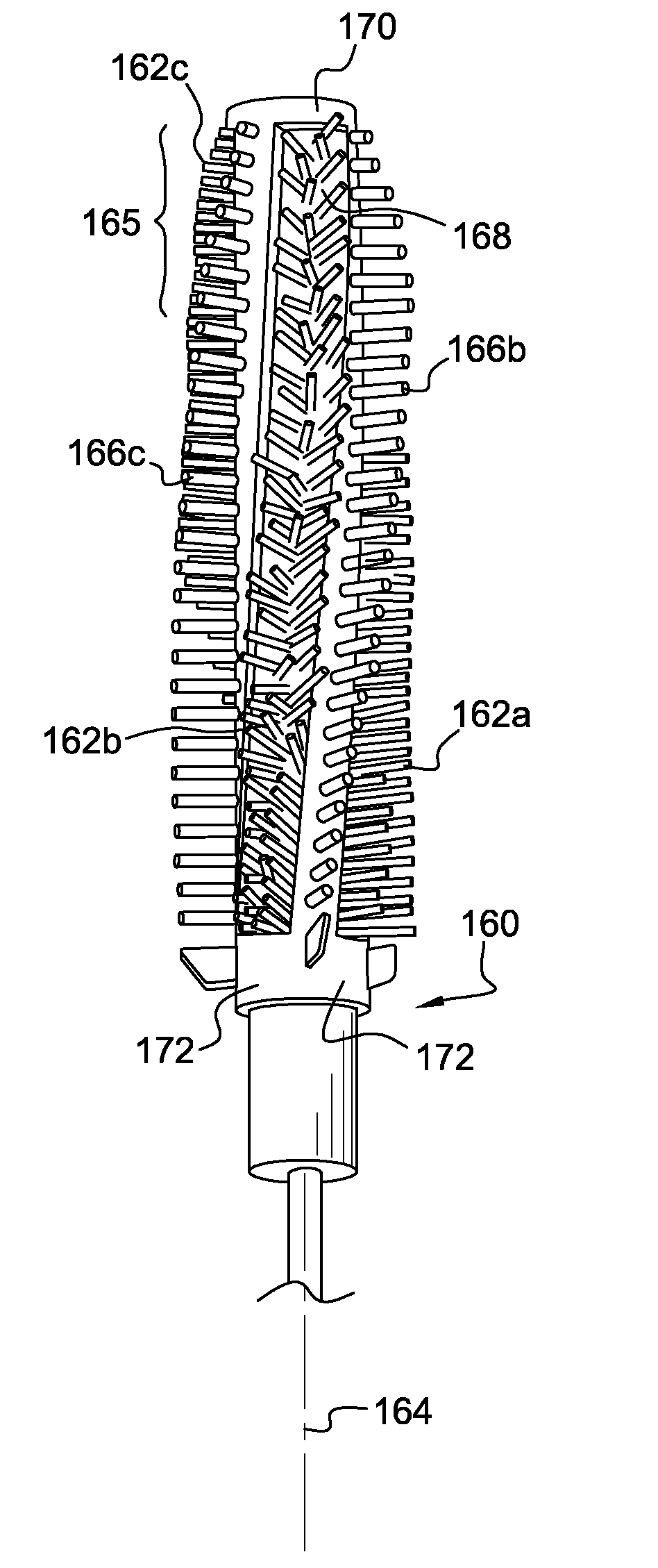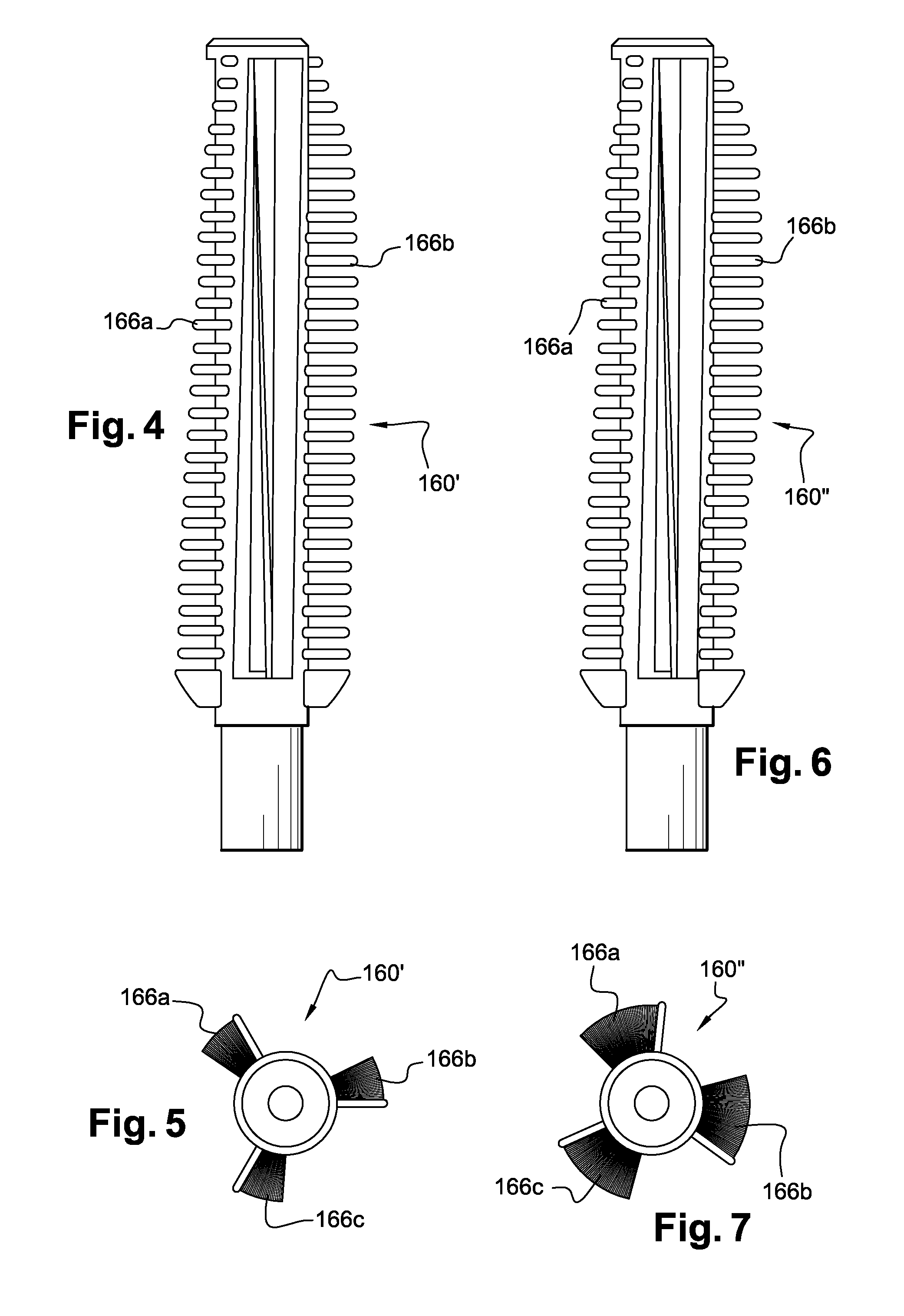Applicator for applying a composition to the eyelashes
- Summary
- Abstract
- Description
- Claims
- Application Information
AI Technical Summary
Benefits of technology
Problems solved by technology
Method used
Image
Examples
Example
[0065]With reference to FIGS. 2 & 3, the endpiece of the first embodiment includes three brush sectors 162a, 162b, and 162c, each extending from one longitudinal end of the endpiece to the other. The three sectors are distributed uniformly about the longitudinal axis 164 of the endpiece that is the longitudinal axis of the stem 14.
[0066]The endpiece also includes three combs 166a, 166b, and 166c that are also evenly distributed about the axis 164, with each comb extending from one end of the endpiece to the other. The combs alternate with the brush sectors, about the axis 164. Each brush sector is equidistant from the two adjacent combs and vice versa. As a result, the brush sectors 162a, 162b, and 162c are separated from one another by one third of a turn about the axis 164, i.e. by 120°. The same applies for the mutual spacing between the combs. As a result, each brush sector presents an angular spacing of 60° with each adjacent comb. The brush sectors are positioned in stationary...
Example
[0085]A second embodiment of the endpiece of the applicator of the invention is shown in FIGS. 10 & 11. The endpiece of this applicator 260 has a general configuration that is very close to the configuration in FIGS. 2 & 3. It thus includes a plurality of brush sectors and a plurality of combs. However, in this embodiment, the number of brush sectors 262a, 262b, 262c, and 262d is four, as is the number of combs 266a, 266b, 266c, and 266d. Once again, the brushes alternate with the combs, about the axis 264.
[0086]The pitch of the helix in this embodiment is such that the angular offset between the first tooth and the last tooth of each comb is 90°. Naturally, it is possible to modify this angular offset while keeping the number of brush sectors equal to four, and the number of combs equal to four.
[0087]This is shown in the following two variants. Thus, with reference to FIGS. 12 & 13, a variant of the endpiece of the applicator in FIGS. 10 & 11 is shown that differs therefrom only by...
Example
[0088]A third embodiment of the applicator of the invention is shown in FIGS. 16 & 17. The endpiece of this applicator differs from the applicator in FIGS. 2 & 3 only by the fact that each of the three combs 366a, 366b, and 366c is constituted not by a single row of teeth but by two rows of teeth 366a1&366a2, 366b1&366b2, and 366c1&366c2. In each row, the teeth are disposed precisely one behind another so as to form a helix. The distance between the two rows is constant along the comb. Also in each row, the teeth have a radial orientation relative to the axis 374 of the stem, such that the teeth of a row are closer at their bases to the teeth of the other row than they are at their tips. It should be observed that the angular distance between the two rows of each comb is much less than the angular distance between one comb and another comb. By way of example, the distances are 20° and about 100° respectively. The presence of two rows of teeth in each comb makes it possible to form s...
PUM
 Login to View More
Login to View More Abstract
- at least one brush sector comprising a row of fibers and
- at least one comb comprising a row of teeth and having a shape that is generally helical.
Description
Claims
Application Information
 Login to View More
Login to View More - R&D
- Intellectual Property
- Life Sciences
- Materials
- Tech Scout
- Unparalleled Data Quality
- Higher Quality Content
- 60% Fewer Hallucinations
Browse by: Latest US Patents, China's latest patents, Technical Efficacy Thesaurus, Application Domain, Technology Topic, Popular Technical Reports.
© 2025 PatSnap. All rights reserved.Legal|Privacy policy|Modern Slavery Act Transparency Statement|Sitemap|About US| Contact US: help@patsnap.com



